Last Updated: May 13, 2024
Exploring Monteverde’s cloud forest by day will let you enjoy views of mossy trees, twisted roots, and misty horizons. Wildlife, however, can be hard to find in these dense woodlands. While it may seem counterintuitive, cloud-forest creatures can be much easier to spot at night. In this post, we’ll share our experience on a Monteverde night walk.
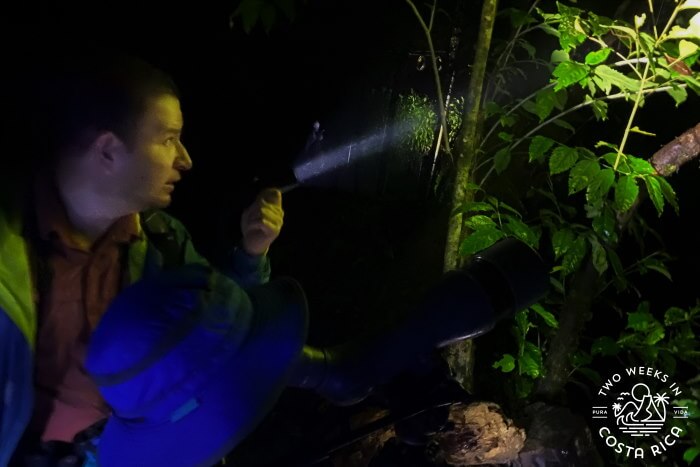
Location
Monteverde is an iconic destination in Costa Rica. The quaint mountain town sits at about 4,200 feet (1,300 meters) in elevation, right along the Continental Divide. This means that the mountains sweep down toward the Pacific Ocean in one direction and the Caribbean Sea in the other. From some spots in town, you can see the Pacific on a clear day.
At this Divide, wind and wet weather converge to create a lush, green, and cloudy environment. These elements make for the perfect hiding place for many species of birds, insects, reptiles, and mammals.
Our Night Walk Experience
Our night walk started at the Monteverde Wildlife Refuge where we met our guide, Esteban. It was about 6 p.m. and darkness was falling quickly over the forest.

In Costa Rica, the sun sets on a regular schedule because of its proximity to the equator. So, by 6 p.m., it is almost always dark, year-round.
Starting the Tour
After some introductions, we quickly got started on the tour. It was just our family, which was nice since we had our two young boys with us (ages 3 and 6 at the time).
With a sprinkle of rain hitting our heads, we set off with flashlights in hand. Esteban, our certified naturalist guide, explained that it was important for us to stay on the trail and let him lead the way. There were things in the forest that could potentially be dangerous.
A Short History Lesson
Walking up a small hill, Esteban told us about the land that made up the Monteverde Wildlife Refuge.
The property began as a large dairy farm. Over time, the owners began to see the environmental significance of their land. They also realized that tourism could eventually replace the farm’s earnings.
People from around the globe were showing up in Monteverde to view the beautiful landscapes and many birds and animals. The family transitioned from farming to conservation, and the forest quickly returned.
As we walked the uneven path, it was hard to believe that fields and barns once made up the land. Our flashlights beamed up at giant trees and through broad-leafed shrubs and wispy vines.
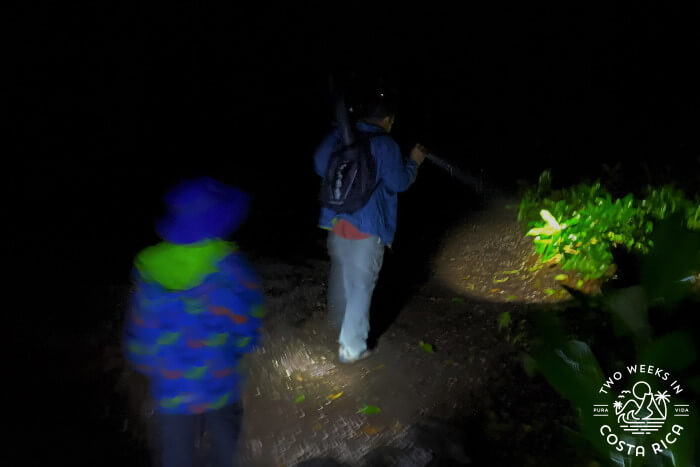
First Wildlife Encounters
It wasn’t long before Esteban had found something for us to take a closer look at. It was a golden-orb spider perched in its web. The silk from this spider, he told us, was one of the strongest materials in the world. It is even used to make bullet-proof clothing.
As we looked at the large black and gold spider with our flashlights, we heard some excitement on the trail nearby. Esteban listened for a moment and then told us that another group had seen a snake.
Weaving our way along the trail behind him, we came to another guide and small group. The two guides made an exchange in Spanish along with some pointing.
Esteban set up his scope after the group left. Taking a closer look, he told us that it was indeed a snake—the same one he had seen for the past few days in this very spot. He thought it may have eaten a large meal and was now digesting it while staying on the same branch.
The snake was about 30 feet (9 meters) away, but through Esteban’s scope we could see it in close detail. It was a side-striped palm-pit viper.
The snake was dark green with a light yellow belly. Its head was triangular, telling us it was likely venomous. Esteban confirmed that it was a dangerous snake and told us it was one of the most common in the cloud forest. This one was about 2-feet (0.6 meters) long.
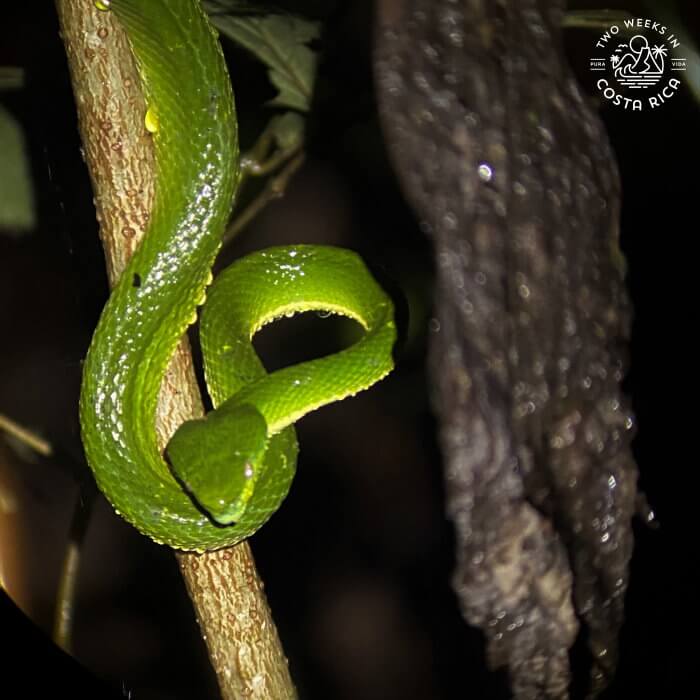
After the snake sighting, everyone stayed especially close to Esteban as we continued down the trail. Now the rain had returned, but we kept mostly dry under umbrellas and raincoats.
Interesting Insects
As we walked, we saw many interesting insects along the way. One was a katydid, a sort of grasshopper that looks exactly like a leaf. Esteban quizzed our oldest son (age 6) about why it would look like that. They then had a discussion all about camouflage and predators.
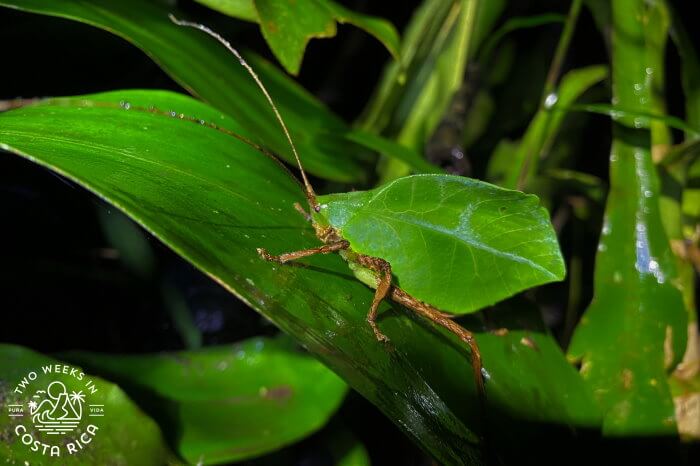
There were also a lot of stick bugs of various shapes and sizes. Talk about camouflage, these awkward bugs blended in so well that, even when they were close by, they looked just like dead sticks.
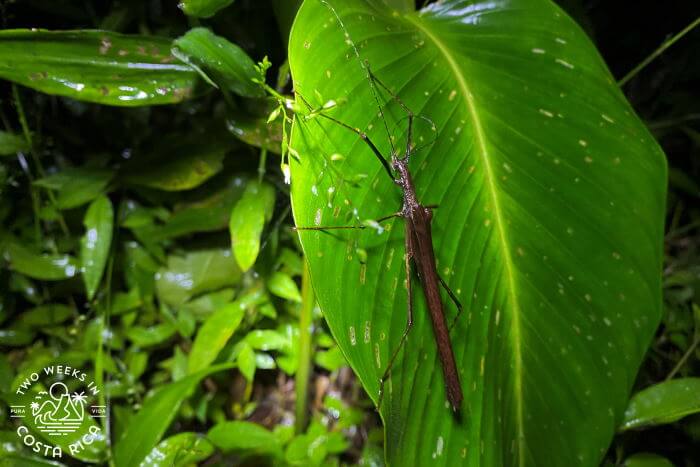
Esteban did an excellent job explaining that most creatures living in the cloud forest try to blend in as best they can. If they are left exposed, they may get snatched up by a predator. That is why they are especially hard to see during the day. At night, they move around much more, using the darkness for additional protection.
The River Trail
Esteban could see that our family was getting a bit wet and tired. In fact, our three-year old was strapped onto Jenn’s back fast asleep in the carrier. At the next trail intersection, he asked if we wanted to go back or do a short loop down to the river.
We appreciated his flexibility but those of us who were still awake were ready to see more. Esteban reassured us that usually some cool stuff was found down by the river.
At the bottom of some steps, we were rewarded.
Esteban shined his light into the trees where a beautiful Keel-billed Toucan was perched. We had woken him from his slumber, but he sat still, allowing us to get the scope set up. Drops of rain dripped from the toucan’s large colorful beak as we watched through the special lens.
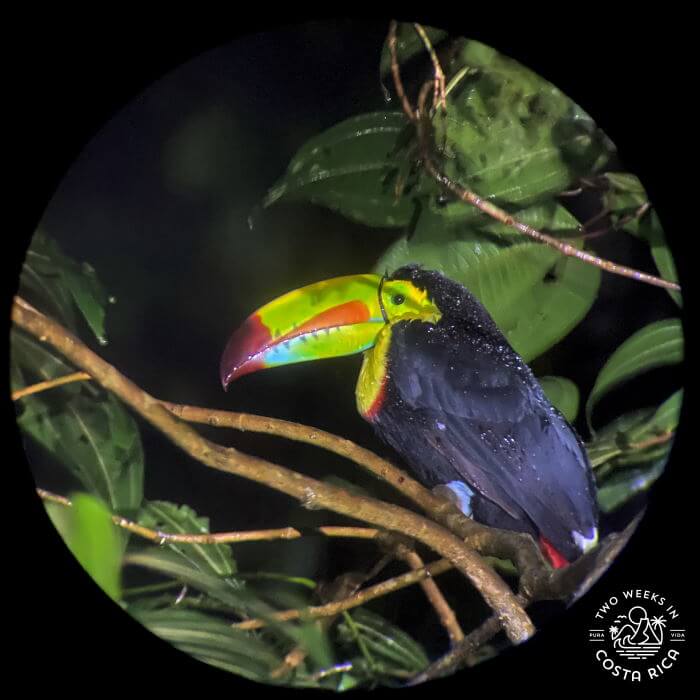
We continued forward, letting the bird doze back to sleep.
Farther up the trail we saw another side-striped palm-pit viper snake. This one was a baby, only about 8 inches (20 cm) long. It was curled up on some barbed-wire fence.
And close to the water, Esteban was able to focus his scope on some frog eggs. He explained that the eggs were safer up in a tree, hidden under the leaves. When they hatched into tadpoles, they would drop down into the water and then develop into baby frogs.

One Last Critter
Our final highlight was on the walk back to the reception area. The group ahead of us had stopped and were shining their lights into the branches above. To be honest, they were being very loud and obnoxious. Soon we learned why. There, creeping along through the canopy, was a two-toed sloth.
We have seen sloths all over Costa Rica and at the Sloth Sanctuary in Monteverde. But this was the first time we had seen one in the wild, in Monteverde. With the rain, we weren’t able to snap a good picture, but it was still really fun to see.
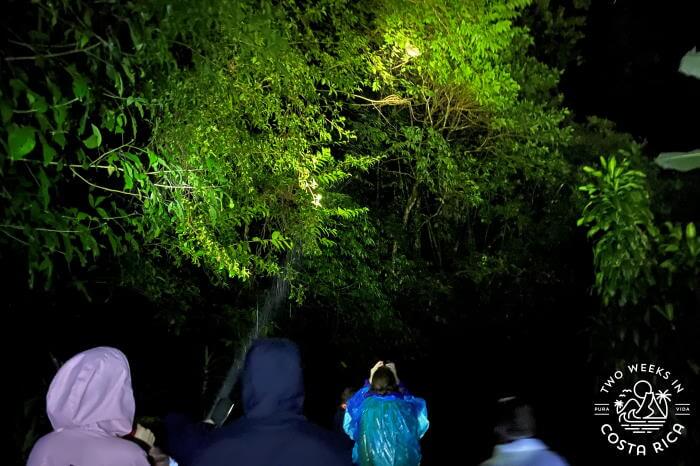
Concluding Our Tour
Back at the reception area and out of the rain, we said goodbye to Esteban and thanked him for a great experience. Taking a night walk tour in Costa Rica’s cloud forest was an adventure, maybe a little wet, but totally worth it.
Booking a Night Tour in Monteverde
If you would like to book your own night tour adventure, we can help. Just use the link below and we will contact the guide and his team to secure your reservation. Booking through us costs the same and helps support our website. You won’t pay until your reservation is confirmed. Learn more about our booking process here.
Note: The guide we use now takes people to a different reserve right next to the Monteverde Wildlife Refuge. This reserve (Santamaria Reserve) is a little less busy and has a lower admission price. The experience and trail conditions are very similar, though.
Tour Details
The night walk tour is about 2 hours and includes a bilingual naturalist guide and flashlight. Transportation is available for an additional charge.
Cost of Guided Private Tour
$50 per person adults and children ages 4 and up + admission ($7 per person)
Self-guided night tours are not allowed for safety.
Tour Start Time & Duration
Night walks start around 6:00 p.m., just after sunset. The tour lasts about 2 hours.
Have a question about the night walk in Monteverde? Have you been? What did you see? Leave us a comment below.
Last Updated: May 13, 2024
Looking for more information to help you plan? Check out these posts:
Selvatura Park: Cloud Forest Hanging Bridges Walk – If you are looking to check hanging bridges off your list, this is one of our favorite places.
Monteverde Hummingbird Gallery – Stay alert as hummingbirds are darting all around you. This quick stop is the perfect add-on to a hike or adventure activity in the cloud forest.
Curi-Cancha Reserve: Avoiding the Crowds in Monteverde – With a limit to the amount of visitors let in at any one time, the Curi-Cancha Reserve can be a lot less crowded. It’s also a great place for birders.

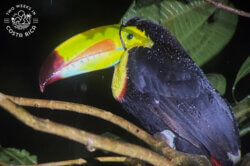
We spent 3 nights in Monteverde. The Hummingbird Gallery, the coffee plantations, the park, the people, and the accommodations were all great. If/when we move to Costa Rica, Monteverde would be the first place I would look at.
We visited Monte Verde in the early 1990s on one of our first trips to Costa Rica. Most memorable was the Humming Bird Gallery with many varieties that we had never seen before (we get Ruby Throats staying and nesting and visiting feeders at home here in Canada).
One other memory comes from the way down where the guide had the driver stop the mini-bus at a bridge over a stream. Go down on that side (upstream) so we did – icy cold – melted snow from up in the mountains. Now go and check on the other side and put your hand in the stream again. I put it and withdrew it quickly. Scalding! Apparently there was a volcanic fumerole (?) venting right under the bridge and on the downstream side there was a strong smell of sulphur!
Hello, we’re coming to CR in April for 2 weeks. I’ve heard that Monteverde is beautiful. I’m curious how much time you recommend to stay in the Monteverde area. We were not planning on having a car for that portion of the trip and we’d like to have enough time to make our way to the Corcovado area.
Hi Jane, We recommend a minimum of 2 nights in Monteverde due to travel time, 3 nights is ideal so that you have two full days for activities.
Here is a link to our Monteverde Hotel Guide with some options for hotels near town where you don’t need a rental car.
If you pay for day access to one of the parks do you have to pay again for the night tour?
We would be interested in booking a night tour (and possibly a day tour). Would you be able to recommend a guide/company to use?
Hi Jamie, We think that the ticket would be good for the whole day but aren’t sure. If you decide to book a tour, we can check.
We book night and days tours in Monteverde. You can use the link in our night tour post or here’s the link to our Monteverde tours’ page. If you request a booking, we’ll reach out to the tour guide to make the reservation and keep you updated by email.
Hi,
Did a three years old pay for the nigth tour?
Thanks,
Audrey
Hi Audrey, Kids under 4 are free. If you’d like to arrange a tour, feel free to reach out through our booking page. Thanks!